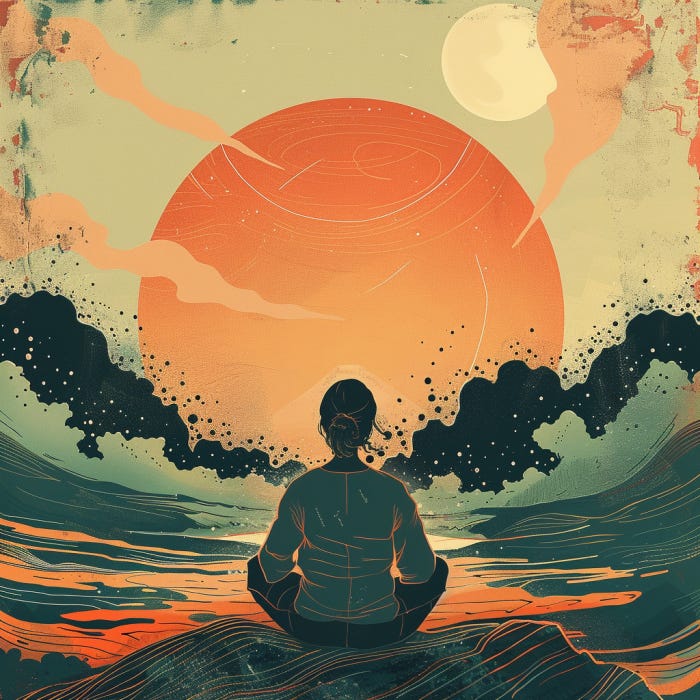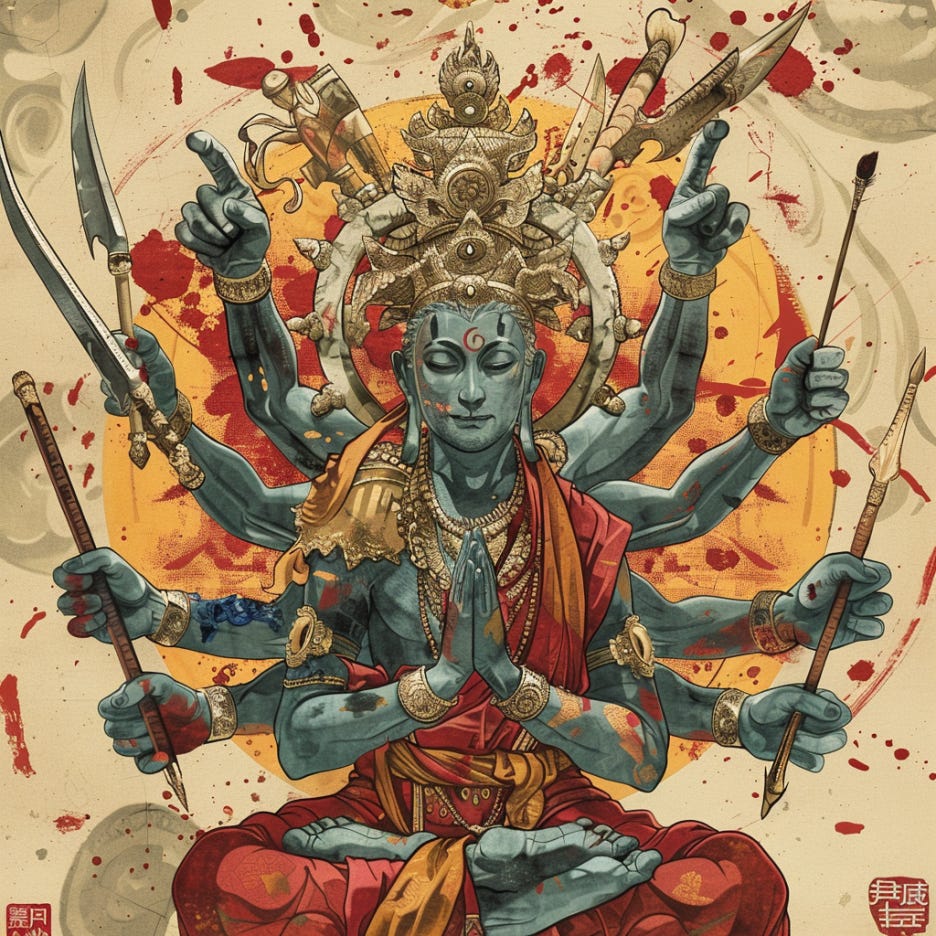4. Zen and the Art of Saving the Planet
The Art of Non-Striving: The Warrior/The Mediator/The Artist within Us
Welcome!
I’m so glad you’re here for our buddy read of Zen and the Art of Saving the Planet. In case you’ve missed previous dispatches you can read previous posts here.
This Week’s Pages:
In this week's pages, we unwrap the quiet rebellion of engaged action, calling us to cultivate resonant stillness in a world that mistakes motion for progress. We meet the unexpected teachers within us: the Meditator, the Artist, and the Warrior, who collectively guide us toward a richer practice of presence and urge us to see beyond the conventional hustle, tuning into a more profound frequency of creativity and courage. And through the Triple Trainings—mindfulness, concentration, insight—we rediscover the power of a focused mind, the clarity of true insight, and the serenity of the present moment, standing in stark defiance to the clamorous chorus of modern life's distractions.
Idea #1: Being Instead of Acting.
Thay's teachings remind us of a compelling truth: "If you don’t have enough peace, understanding, and tolerance... your action will have little value." This statement challenges us to reconsider the essence of our actions. In our book club, we’re exploring how the quality of our being directly informs the value of our doings.
In the world of Zen, the profound concept of 'non-action' emerges—not a lack of action, but a presence so full and complete that it becomes an action in itself. It's about understanding that a calm and mindful presence can have a greater impact than a flurry of activities. "Sometimes you don’t do anything, but you do a lot," Thay tells us, inviting us to find potency in stillness and intentionality in our non-reactions.
As Thay cautions, without addressing the roots of inner turmoil, the surface-level actions, even meditative practices, may not change underlying discord. It’s not the meditation itself but the transformation it fosters within us that brings about change. This insight propels us to seek alignment between our inner state and the outward peace we desire.
Idea #2: The Meditator/The Artist/ The Warrior
Within each of us, there resides a trio of profound archetypes: the Meditator, the Artist, and the Warrior. These facets of our being, when harmonized, create a balanced approach to living mindfully and acting purposefully.
The Meditator in us seeks the silence between thoughts, the deep breath of life that brings clarity and insight. It is the part that yearns for practice, not for the sake of ritual alone but for the transformation it promises. This aspect embodies our quest for enlightenment, guiding us to lucidity and calm. It’s the inner voice that urges us to become better, to cultivate the best in ourselves, to sit with our thoughts and emerge with wisdom. The practice of the Meditator is the undercurrent of our existence, providing depth to our every action.
Then, there's the Artist, the source of our creativity and the bringer of joy and freshness to our experiences. The Artist within does not just create; it infuses our mindfulness practice with a sense of wonder, making each moment a canvas for expression and each breath a stroke of the brush. This joyful spirit within us teaches that our path through life should not be a grim march but a dance, a celebration that's both nourishing and healing. Through the Artist's eyes, we learn to find joy in the mundane, crafting beauty from the ordinary.
Contrasting the tranquility of the Meditator and the vibrancy of the Artist is the Warrior, the embodiment of our determination. This is the relentless force that urges us to move forward, to conquer challenges and emerge victorious. The Warrior within does not cower before obstacles; instead, it sees them as catalysts for growth—an accelerator of wisdom and aspiration. It is the part of us that, when faced with adversity, squares its shoulders, ready to forge ahead with an indomitable spirit.
Obstacles, according to the wisdom of these internal guides, are not barriers but the fire that tempers our resolve. They are opportunities for the Warrior to express courage, for the Meditator to gain insight, and for the Artist to find inspiration. It's not the avoidance of challenges that defines us but our response to them. They refine our character, sharpen our focus, and expand our understanding.
To live a truly balanced life, we must invite each of these aspects to surface in their own time. The Meditator brings us wisdom, the Artist joy, and the Warrior the will to act. When these three converge, our actions become infused with clarity, creativity, and courage. We are then fully equipped to face the world not as fragmented beings but as whole persons, each part working in harmony to navigate the ebb and flow of existence.
Idea #3: The Triple Trainings:
Thay's "Triple Trainings" in mindfulness, concentration, and insight offer us a profound framework for personal growth and inner peace. This holistic practice is a cornerstone for anyone looking to deepen their understanding of the self and the world. Mindfulness, the first training, calls us to be fully present in the moment, to live with awareness and a deep appreciation for the here and now. It’s a remedy against the autopilot mode that life’s fast pace often pushes us into, reminding us that each moment is an opportunity for connection and joy.
Concentration, the second training, is about focusing our mental faculties with laser precision. It's the ability to hold our attention steady, to dive deep into whatever we are doing – whether it's work, conversation, or reflection. Thay suggests that a solid practice in concentration gives us the power to remain unshaken by the tremors of daily life. With such focus, joy and happiness aren’t just fleeting emotions but sustainable states of being, leading to peace, harmony, and reconciliation even amid pain and confusion.
Insight, the third training, is the natural progression from mindfulness and concentration. It is the profound understanding that bubbles up from the depths of a well-tended mindful presence and steadfast concentration. Insight is the illumination of our experiences, shedding light on our patterns, behaviors, and the interconnectedness of all things. It allows us to handle life's challenges with a serene wisdom, ensuring that we’re not merely reactive beings but proactive architects of our destiny.
Yet, as Thay points out, the opposite of mindfulness is forgetfulness – a state where we’re lost to the past or future, missing the very essence of life. "Forgetfulness means that you are pulled away by the past, by the future, by your projects, by your anger, by your fear. You’re not truly alive." It’s a profound reminder that the seeds of mindfulness within us need nurturing through intentional practice. Simple acts like drinking tea, breathing, or taking a mindful shower can strengthen this seed, gradually transforming our interactions with ourselves and the world.
In a profound call to action, Thay emphasizes the diligence required in this practice: “But very few of us are willing to spend three or six months, or even a year, training ourselves to handle our sadness or our anger, to listen with compassion, and to use loving speech." It’s an invitation to invest time and effort into cultivating the Triple Trainings, which can ultimately make us heroes in our own right – champions of happiness capable of bringing light to the darkest corners, not just for ourselves, but for many others. Such is the path laid out by Thay, one that promises a life rich with understanding, harmony, and a profound sense of aliveness.
Reflection questions
In what situations do you find yourself reacting automatically, and how can you cultivate a moment of stillness before responding?
How can you balance the Meditator's calm, the Artist's creativity, and the Warrior's determination in your daily life?
What steps will you take to ensure that you are truly present and alive in your daily interactions, not lost in forgetfulness?
Foushy Feedback: On Letting Go of Ambition (for a while)
Diving into this week’s reading we're confronted with a conundrum that flies in the face of all our modern-day instincts: the potent, paradoxical idea of non-striving. In the midst of a world that rewards hustle, valorizes packed schedules, and confuses stillness with idleness, the invitation to stop trying so hard feels like a cool hand on a fevered forehead.
The twist comes when we discover who teaches us this stillness. We expect the lesson to come from the Meditator, serene in contemplation. Instead, it's also the Artist and Warrior within us who counsel pause and reflection. The Artist redefines our conception of productivity, showing us that creativity can flourish in the moments we allow ourselves to simply be. The Warrior, too, isn't always in a state of fight or flight but can stand guard, ensuring the sanctity of our inner calm against the onslaught of daily life.
Then there's the very practical act of developing concentration and insight, skills that seem almost quaint in a world awash with constant notifications and multitasking. But these practices aren't relics; they're revolutionary acts of rebellion against the fragmentation of our attention. They're how we reclaim our minds from the claws of perpetual background noise, from the pervasive feeling of never being enough, never doing enough.
Against this backdrop of endless buzz and distractions, the notion of 'just being' is almost revolutionary. It's the antithesis to the nagging sense of always playing catch-up with an ever-accelerating world.
But there's a profound freedom in letting go of the rush, a balm in knowing that we're not lagging behind—because in the grand, sprawling timeline of existence, there's no such thing as 'behind.'
This year, personal turbulence tossed me into the relentless tides of global events, and I felt my grip on ambition slipping. The guilt and stress that bubble up from not hitting every self-imposed milestone can be asphyxiating. What relief, then, to embrace this period of non-striving, to allow the space for stillness. Trusting in one's own pace isn't negligence; it's an act of radical self-care. And maybe, just maybe, it's okay to move at a tempo that makes sense to me, to us, amid a world that's lost its metronome.
Next Week’s Pages: Global Ethics, Reverence for Life & Deep Simplicity.
How did you feel about this week’s readings?







Hello Rahaf! Once again thank you for sharing these deep ideas.
These ideas resonates deeply with me this week especially, as I once again tend to struggle with my immediate reaction to events or even little stuff happening in my life. I tend to switch to frantic thoughts about how I can act right away, and these are not calm thoughts. I need to bring out the Meditator in myself, I think this will be my focus at least for the next few days!
I really like this topic. It reminds me of what was discussed in Hustle & Float. Learning to slow down and focus is really important for my mental health and for our actual world.
Thank you for treating that subject and sharing these book summaries with us